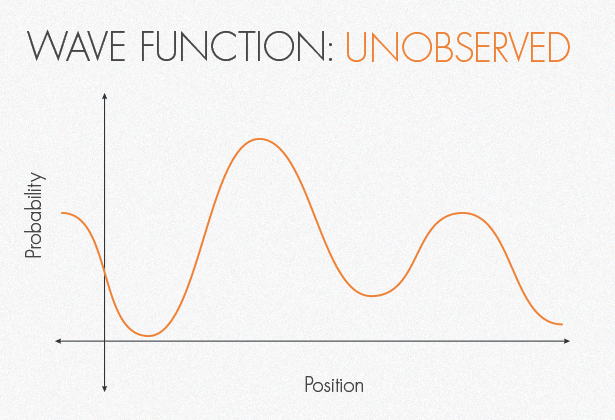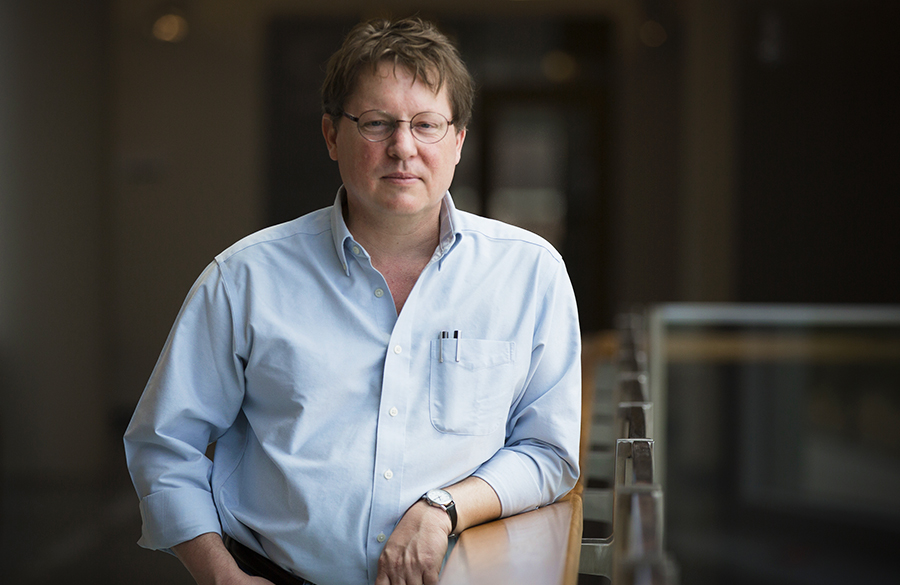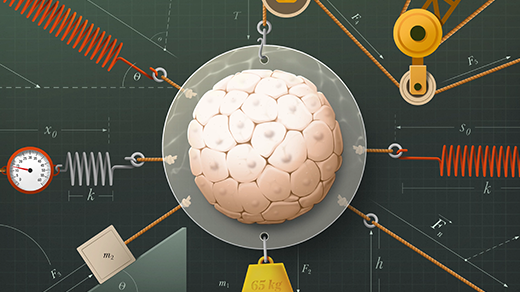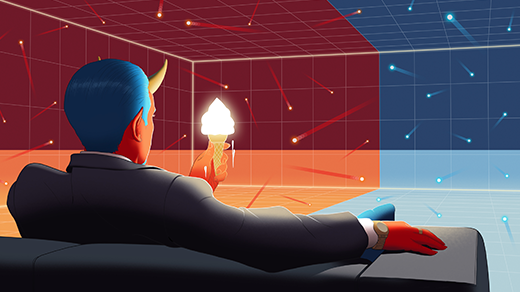A Private View of Quantum Reality
Christopher Fuchs describes physics as “a dynamic interplay between storytelling and equation writing. Neither one stands alone, not even at the end of the day.” And indeed Fuchs, a physicist at the University of Massachusetts, Boston, has a radical story to tell. The story is called QBism, and it goes something like this.
Once upon a time there was a wave function, which was said to completely describe the state of a physical system out in the world. The shape of the wave function encodes the probabilities for the outcomes of any measurements an observer might perform on it, but the wave function belonged to nature itself, an objective description of an objective reality.
Then Fuchs came along. Along with the researchers Carlton Caves and Rüdiger Schack, he interpreted the wave function’s probabilities as Bayesian probabilities — that is, as subjective degrees of belief about the system. Bayesian probabilities could be thought of as gambling attitudes for placing bets on measurement outcomes, attitudes that are updated as new data come to light. In other words, Fuchs argued, the wave function does not describe the world — it describes the observer. “Quantum mechanics,” he says, “is a law of thought.”
Quantum Bayesianism, or QBism as Fuchs now calls it, solves many of quantum theory’s deepest mysteries. Take, for instance, the infamous “collapse of the wave function,” wherein the quantum system inexplicably transitions from multiple simultaneous states to a single actuality. According to QBism, the wave function’s “collapse” is simply the observer updating his or her beliefs after making a measurement. Spooky action at a distance, wherein one observer’s measurement of a particle right here collapses the wave function of a particle way over there, turns out not to be so spooky — the measurement here simply provides information that the observer can use to bet on the state of the distant particle, should she come into contact with it. But how, we might ask, does her measurement here affect the outcome of a measurement a second observer will make over there? In fact, it doesn’t. Since the wavefunction doesn’t belong to the system itself, each observer has her own. My wavefunction doesn’t have to align with yours.

In a sea of interpretations of quantum weirdness, QBism swims alone. The traditional “Copenhagen interpretation” treats the observer as somehow standing outside of nature, imbued with mysterious wave-function-collapsing powers, governed by laws of physics that are different from those that govern what’s being observed. That’s all well and good until a second observer comes along to observe the first observer. The “many worlds” interpretation claims that the universe and all of its observers are described by a single, giant wave function that never collapses. Of course, to make that work, one must insist that at every fork in the road — every coin toss, every decision, every moment — the wave function branches and so do we, splitting into countless versions of ourselves who have collectively done and not done everything we’ll ever do or not do. For those to whom a set of infinite parallel realities is too high a price to pay to avoid wave-function collapse, there’s always the Bohmian interpretation, which seeks to restore a more concrete reality to the world by postulating the existence of a guiding force that permeates the universe and deterministically governs everything in it. Unfortunately, this new reality lies forever out of reach of scientific probing.
Those interpretations all have something in common: They treat the wave function as a description of an objective reality shared by multiple observers. QBism, on the other hand, treats the wave function as a description of a single observer’s subjective knowledge. It resolves all of the quantum paradoxes, but at the not insignificant cost of anything we might call “reality.” Then again, maybe that’s what quantum mechanics has been trying to tell us all along — that a single objective reality is an illusion.
QBism also raises a host of new and equally mysterious questions. If the wave function describes an observer, does the observer have to be human? Does that observer have to have consciousness? Could it be a dog? (“Dogs don’t use wave functions,” Fuchs said. “Heck, I didn’t collapse a wave function until I was 34.”) If my wave function doesn’t have to align with yours, do we live in the same universe? And if quantum mechanics doesn’t describe an external reality, what does?
Fuchs struggles with these questions, often working through his thoughts in the form of emails. His missives have become legendary. For two decades Fuchs has compiled them into huge documents — he calls them his samizdats — which have made the rounds among quantum physicists and philosophers as a kind of underground manuscript. After Fuchs lost his Los Alamos home to a fire in May 2000, he decided to back them up by posting them on the scientific preprint site arxiv.org as a massive paper, which was later published by Cambridge University Press as a 500-page book. A second samizdat was released 13 years later with an additional 2,300 pages. The emails reveal both Fuchs’ searching mind and his colorful character. As the physicist David Mermin puts it, “If Chris Fuchs did not exist then God would have been remiss in not inventing him.”
So how will the QBism story end? Ultimately, Fuchs wants to answer a single question, one famously asked by the eminent physicist John Archibald Wheeler, who was Fuchs’ mentor: Why the quantum? That is, why should the world be built in such a way that it can only be described by the strange rules of quantum mechanics?
In the meantime, Quanta caught up with Fuchs at a coffee shop in Cambridge, Massachusetts, to ask him some questions of our own. An edited and condensed version of our conversation follows.
QUANTA MAGAZINE: You’ve said, “I knew I had to become a physicist, not for the love of physics, but for the distrust of it.”
CHRISTOPHER FUCHS: I was a big science fiction fan when I was a kid. I grew up in a small town in Texas and I really enjoyed the idea of space flight. It seemed inevitable — we were going to the moon, that was just the first step, science is limitless and eventually we’d be doing the things they do in Star Trek: go to planets, find new creatures, have adventures. So I started reading books about physics and space travel, and it was there that I first learned that space travel would be difficult because of the great distances between stars. How do you get around this? I learned about John Wheeler and black holes and wormholes, and that possibly wormholes could be a way to get around the speed-limit problem, or we could get past the speed limit using exotic particles called tachyons. I ate the stuff up. Most of it turned out to be pretty improbable; wormholes had proven to be unstable and nobody really believed in tachyons. Overall, the message to me was that physics wouldn’t allow us to get to the stars. As a bit of a joke, I would tell my friends, if the laws of physics won’t allow us to go to the stars, the laws of physics must be wrong!
Probability does not exist! It will go the way of phlogiston, witches, elves and fairies.
You ended up studying with John Wheeler.
The first time I went to the University of Texas, it dawned on me that the guy I’d read about years before, John Wheeler, was actually a professor there. So I went and read some of his newer papers, in which he was talking about “law without law.” He’d say things like, “In the end, the only law is that there is no law.” There’s no ultimate law of physics. All the laws of physics are mutable and that mutability itself is a principle of physics. He’d say, there’s no law of physics that hasn’t been transcended. I saw this, and I remembered my joke about how the laws of physics must be wrong, and I was immensely attracted to this idea that maybe ultimately there actually are no laws of physics. What there is in place of laws, I didn’t know. But if the laws weren’t 100 percent trustworthy, maybe there was a back door to the stars. It was all youthful romanticism; I hadn’t even had a physics course yet.
In one of your papers, you mention that Erwin Schrödinger wrote about the Greek influence on our concept of reality, and that it’s a historical contingency that we speak about reality without including the subject — the person doing the speaking. Are you trying to break the spell of Greek thinking?
Schrödinger thought that the Greeks had a kind of hold over us — they saw that the only way to make progress in thinking about the world was to talk about it without the “knowing subject” in it. QBism goes against that strain by saying that quantum mechanics is not about how the world is without us; instead it’s precisely about us in the world. The subject matter of the theory is not the world or us but us-within-the-world, the interface between the two.
It’s so ingrained in us to think about the world without thinking of ourselves in it. It reminds me of Einstein questioning space and time — these features of the world that seemed so absolute that no one even thought to question them.
It’s said that in earlier civilizations, people didn’t quite know how to distinguish between objective and subjective. But once the idea of separating the two gained a toehold, we were told that we have to do this, and that science is about the objective. And now that it’s done, it’s hard to turn back. I think the biggest fear people have of QBism is precisely this: that it’s anthropocentric. The feeling is, we got over that with Copernicus, and this has got to be a step backwards. But I think if we really want a universe that’s rife with possibility with no ultimate limits on it, this is exactly where you’ve got to go.
How does QBism get you around those limits?
One way to look at it is that the laws of physics aren’t about the stuff “out there.” Rather, they are our best expressions, our most inclusive statements, of what our own limitations are. When we say the speed of light is the ultimate speed limit, we’re saying that we can’t go beyond the speed of light. But just as our brains have gotten bigger through Darwinian evolution, one can imagine that eventually we’ll have evolved to a stage where we can take advantage of things that we can’t now. We might call those things “changes in the laws of physics.” Usually we think of the universe as this rigid thing that can’t be changed. Instead, methodologically we should assume just the opposite: that the universe is before us so that we can shape it, that it can be changed, and that it will push back on us. We’ll understand our limits by noticing how much it pushes back on us.
Let’s talk about probability.
Probability does not exist! Bruno de Finetti, in the intro to his two-volume set on probability theory, writes in all-capital letters, “PROBABILITY DOES NOT EXIST.” He says it will go the way of phlogiston, witches, elves and fairies.
When the founders of quantum mechanics realized that the theory describes the world in terms of probabilities, they took that to mean that the world itself is probabilistic.
In Pierre-Simon Laplace’s day, probability was thought of as a subjective statement — you don’t know everything, but you can manage by quantifying your knowledge. But sometime in the late 1800s and early 1900s, probabilities started cropping up in ways that appeared objective. People were using statistical methods to derive things that could be measured in the laboratory — things like heat. So people figured, if this quantity arises because of probabilistic considerations, and it’s objective, it must be that the probabilities are objective as well. Then quantum mechanics came along. The Copenhagen crowd was arguing that quantum mechanics is a complete theory, finished, closed, which was often taken to mean that all of its features should be objective features of nature. If quantum states give probabilities, those probabilities should also be objective features of nature. On the other side of the fence was Albert Einstein, who said quantum mechanics is not complete. When he described probabilities in quantum mechanics, he seemed to interpret them as statements of incomplete knowledge, subjective states.
So when you say that probability doesn’t exist, you mean that objective probability doesn’t exist.
Right, it doesn’t exist as something out in the world without a gambling agent. But suppose you’ve convinced yourself that the right way to understand probability is as a description of uncertainty and ignorance. Now there’s a spectrum of positions you could take. According to the Bayesian statistician I.J. Good, there are 46,656 varieties. When we started working on quantum Bayesianism, we tried to take a stance on probability that was like E.T. Jaynes’ stance: We’ll admit that probabilities are in our heads — my probabilities are in my head, your probabilities are in your head — but if I base my probabilities on the same information that you base yours on, our two probability assignments should be the same. Conditioned on the information, they should be objective. In the spectrum of 46,656 varieties, this stance is called “objective Bayesianism.”
At the other end of the spectrum is Bruno de Finetti. He says there’s no reason whatsoever for my probabilities and yours to match, because mine are based on my experience and yours are based on your experience. The best we can do, in that case, if we think of probabilities as gambling attitudes, is try to make all of our personal gambling attitudes internally consistent. I should do that with mine, and you with yours, but that’s the best we can do. That’s what de Finetti meant when he said probability does not exist. He meant, let’s take the extreme stance. Instead of saying probabilities are mostly in my head but there are some extra rules that still anchor them to the world, he got rid of the anchor.
Eventually my colleague Rüdiger Schack and I felt that to be consistent we had to break the ties with Jaynes and move more in the direction of de Finetti. Where Jaynes made fun of de Finetti, we thought, actually, that’s where the real solution lies.
Is that when the name changed from quantum Bayesianism to QBism?
Quantum Bayesianism was too much of a mouthful, so I started calling it QBism. As soon as I started calling it QBism, people paid more attention to it! But my colleague David Mermin started complaining that QBism really shouldn’t be short for quantum Bayesianism because there are a lot of Bayesians out there who wouldn’t accept our conclusions. So he wanted to call it quantum Brunoism, for Bruno de Finetti. The trouble with that is that there are parts of the metaphysics of QBism that even de Finetti wouldn’t accept!
But then I found the perfect B. The trouble is, it’s so ugly you wouldn’t want to show it off in public. It’s a term that comes from Supreme Court Justice Oliver Wendell Holmes Jr. He described his own philosophy as “bettabilitarianism.” It’s the philosophy that, as Louis Menand said, “the world is loose at the joints.” The best you can do is gamble on the consequences of your actions. [The portmanteau comes from bet and ability.] I think this fits it perfectly, but I don’t want to say that QBism stands for quantum bettabilitarianism, so I think it’s best to do what KFC did. It used to be Kentucky Fried Chicken; now it’s just KFC.
If quantum mechanics is a user’s manual, as you’ve called it, who’s the user? Einstein talked about observers, but an observer in quantum mechanics is different from an observer in relativity.
The other day I was talking to the philosopher Rob DiSalle. He said that the observer is not so problematic in relativity because one observer can, so to speak, “look over the shoulder of another observer.” I like that phrasing. In other words, you can take what one observer sees and use transformation laws to see what the other observer will see. Bohr really played that up. He played up the similarities between quantum mechanics and relativity, and he couldn’t understand why Einstein wouldn’t accept quantum theory. But I think the problems are different. As QBism understands a quantum measurement outcome, it’s personal. No one else can see it. I see it or you see it. There’s no transformation that takes the one personal experience to the other personal experience. William James was just wrong when he tried to argue that “two minds can know one thing.”
Does that mean that, as Arthur Eddington put it, the stuff of the world is mind stuff?
QBism would say, it’s not that the world is built up from stuff on “the outside” as the Greeks would have had it. Nor is it built up from stuff on “the inside” as the idealists, like George Berkeley and Eddington, would have it. Rather, the stuff of the world is in the character of what each of us encounters every living moment — stuff that is neither inside nor outside, but prior to the very notion of a cut between the two at all.
So eventually objectivity comes in?
I hope it does. Ultimately I view QBism as a quest to point to something in the world and say, that’s intrinsic to the world. But I don’t have a conclusive answer yet. Quantum mechanics is a single-user theory, but by dissecting it, you can learn something about the world that all of us are immersed in.
Treating quantum mechanics as a single-user theory resolves a lot of the paradoxes, like spooky action at a distance.
Yes, but in a way that a lot of people find troubling. The usual story of Bell’s theorem is that it tells us the world must be nonlocal. That there really is spooky action at a distance. So they solved one mystery by adding a pretty damn big mystery! What is this nonlocality? Give me a full theory of it. My fellow QBists and I instead think that what Bell’s theorem really indicates is that the outcomes of measurements are experiences, not revelations of something that’s already there. Of course others think that we gave up on science as a discipline, because we talk about subjective degrees of belief. But we think it solves all of the foundational conundrums. The only thing it doesn’t solve is Wheeler’s question, why the quantum?
Why the quantum?
I wish I had more of a sense. I’ve become fascinated by these beautiful mathematical structures called SICs, symmetric informationally complete measurements — horrible name, almost as bad as bettabilitarianism. They can be used to rewrite the Born rule [the mathematical procedure that generates probabilities in quantum mechanics] in a different language, in which it appears that the Born rule is somehow deeply about analyzing the real in terms of hypotheticals. If you have it in your heart — and not everyone does — that the real message of quantum mechanics is that the world is loose at the joints, that there really is contingency in the world, that there really can be novelty in the world, then the world is about possibilities all the time, and quantum mechanics ties them together. It might take us 25 years to get the mathematics right, but in 25 years let’s have this conversation again!
This article was reprinted on Wired.com.




